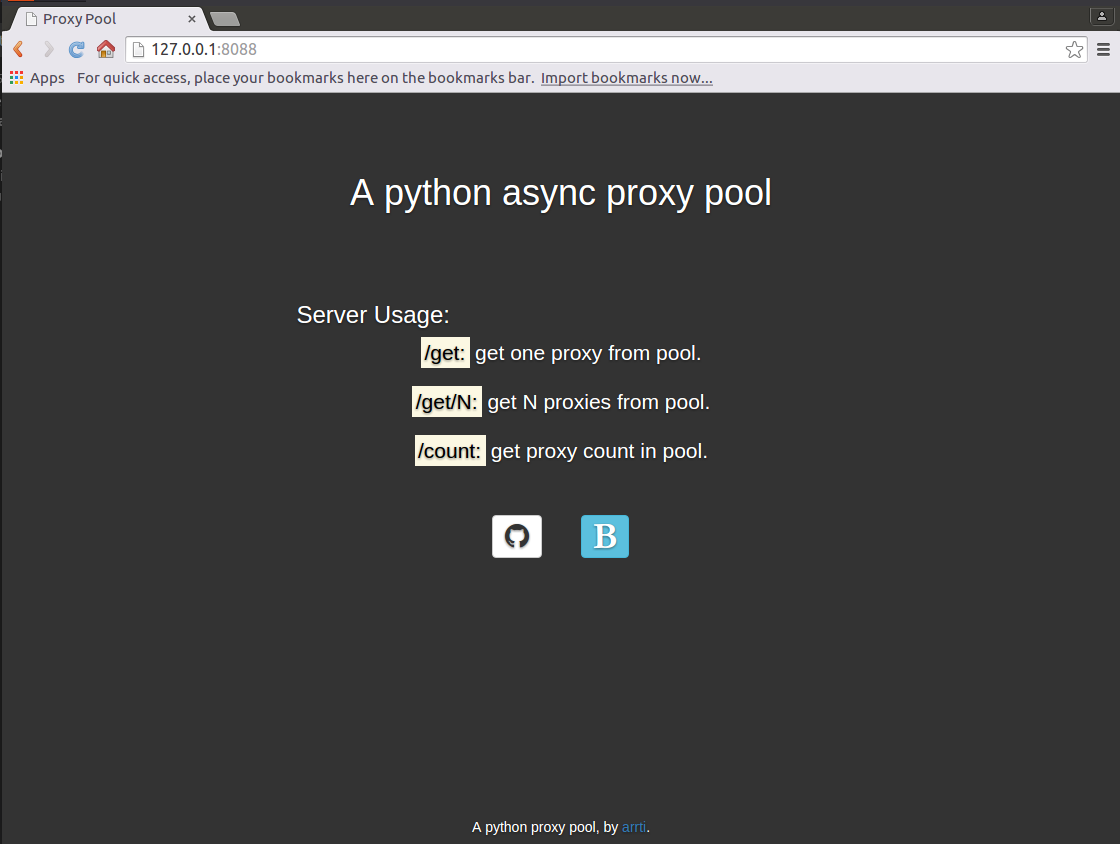利用Python實現非同步代理爬蟲及代理池方法
本文主要介紹了Python實現非同步代理爬蟲及代理池的相關知識,具有很好的參考價值,下面跟著小編一起來看下吧
使用python asyncio實現了一個非同步代理池,根據規則爬取代理網站上的免費代理,在驗證其有效後存入redis中,定期擴展代理的數量並檢驗池中代理的有效性,移除失效的代理。同時用aiohttp實作了一個server,其他的程式可以透過存取對應的url來從代理池取得代理。
原始碼
https://github.com/arrti/proxypool
環境
Python 3.5+
#Redis
- ##PhantomJS(可選)
- Supervisord(可選)
依賴
- #redis
- aiohttp
- bs4
- lxml
- #requests ##selenium
- #selenium套件主要是用來操作PhantomJS的。
下面來說明程式碼。
1. 爬蟲部分
核心程式碼async def start(self):
for rule in self._rules:
parser = asyncio.ensure_future(self._parse_page(rule)) # 根据规则解析页面来获取代理
logger.debug('{0} crawler started'.format(rule.rule_name))
if not rule.use_phantomjs:
await page_download(ProxyCrawler._url_generator(rule), self._pages, self._stop_flag) # 爬取代理网站的页面
else:
await page_download_phantomjs(ProxyCrawler._url_generator(rule), self._pages,
rule.phantomjs_load_flag, self._stop_flag) # 使用PhantomJS爬取
await self._pages.join()
parser.cancel()
logger.debug('{0} crawler finished'.format(rule.rule_name))
produce 1 produce 2 consume 1 produce 3 produce 4 consume 2 produce 5 consume 3 consume 4 consume 5
爬取頁面async def page_download(urls, pages, flag):
url_generator = urls
async with aiohttp.ClientSession() as session:
for url in url_generator:
if flag.is_set():
break
await asyncio.sleep(uniform(delay - 0.5, delay + 1))
logger.debug('crawling proxy web page {0}'.format(url))
try:
async with session.get(url, headers=headers, timeout=10) as response:
page = await response.text()
parsed = html.fromstring(decode_html(page)) # 使用bs4来辅助lxml解码网页:http://lxml.de/elementsoup.html#Using only the encoding detection
await pages.put(parsed)
url_generator.send(parsed) # 根据当前页面来获取下一页的地址
except StopIteration:
break
except asyncio.TimeoutError:
logger.error('crawling {0} timeout'.format(url))
continue # TODO: use a proxy
except Exception as e:
logger.error(e)
,大部分代理網站都可以使用上面的方法來爬取,對於使用js動態產生頁面的網站可以使用selenium控制PhantomJS來爬取-本專案對爬蟲的效率要求不高,代理網站的更新頻率是有限的,不需要頻繁的爬取,完全可以使用PhantomJS。
解析代理程式最簡單的莫過於用
xpath來解析代理程式了,使用Chrome瀏覽器的話,直接透過右鍵就能獲得選取的頁面元素的xpath:
 #安裝Chrome的擴充「XPath Helper」就可以直接在頁面上運作和調試xpath,十分方便:
#安裝Chrome的擴充「XPath Helper」就可以直接在頁面上運作和調試xpath,十分方便:
 BeautifulSoup不支援xpath,使用lxml來解析頁面,程式碼如下:
BeautifulSoup不支援xpath,使用lxml來解析頁面,程式碼如下:
async def _parse_proxy(self, rule, page):
ips = page.xpath(rule.ip_xpath) # 根据xpath解析得到list类型的ip地址集合
ports = page.xpath(rule.port_xpath) # 根据xpath解析得到list类型的ip地址集合
if not ips or not ports:
logger.warning('{2} crawler could not get ip(len={0}) or port(len={1}), please check the xpaths or network'.
format(len(ips), len(ports), rule.rule_name))
return
proxies = map(lambda x, y: '{0}:{1}'.format(x.text.strip(), y.text.strip()), ips, ports)
if rule.filters: # 根据过滤字段来过滤代理,如“高匿”、“透明”等
filters = []
for i, ft in enumerate(rule.filters_xpath):
field = page.xpath(ft)
if not field:
logger.warning('{1} crawler could not get {0} field, please check the filter xpath'.
format(rule.filters[i], rule.rule_name))
continue
filters.append(map(lambda x: x.text.strip(), field))
filters = zip(*filters)
selector = map(lambda x: x == rule.filters, filters)
proxies = compress(proxies, selector)
for proxy in proxies:
await self._proxies.put(proxy) # 解析后的代理放入asyncio.Queue中#爬蟲規則網站爬取、代理解析、濾等等操作的規則都是由各個代理網站的規則類別定義的,使用元類別和基底類別來管理規則類別。基底類別定義如下:
class CrawlerRuleBase(object, metaclass=CrawlerRuleMeta): start_url = None page_count = 0 urls_format = None next_page_xpath = None next_page_host = '' use_phantomjs = False phantomjs_load_flag = None filters = () ip_xpath = None port_xpath = None filters_xpath = ()
各個參數的意義如下:
start_url(必要)爬蟲的起始頁。
(必要)爬取IP的xpath規則。
(必要)爬取連接埠號碼的xpath規則。
爬取的頁面數量。
頁面位址的格式
,透過urls_format.format(start_url, n)來產生第n頁的位址,這是比較常見的頁面位址格式。
next_page_xpath,next_page_host<p>由xpath规则来获取下一页的url(常见的是相对路径),结合host得到下一页的地址:next_page_host + url。</p><p><code>use_phantomjs, phantomjs_load_flag
use_phantomjs用于标识爬取该网站是否需要使用PhantomJS,若使用,需定义phantomjs_load_flag(网页上的某个元素,str类型)作为PhantomJS页面加载完毕的标志。
filters
过滤字段集合,可迭代类型。用于过滤代理。
爬取各个过滤字段的xpath规则,与过滤字段按顺序一一对应。
元类CrawlerRuleMeta用于管理规则类的定义,如:如果定义use_phantomjs=True,则必须定义phantomjs_load_flag,否则会抛出异常,不在此赘述。
目前已经实现的规则有西刺代理、快代理、360代理、66代理和 秘密代理。新增规则类也很简单,通过继承CrawlerRuleBase来定义新的规则类YourRuleClass,放在proxypool/rules目录下,并在该目录下的init.py中添加from . import YourRuleClass(这样通过CrawlerRuleBase.subclasses()就可以获取全部的规则类了),重启正在运行的proxy pool即可应用新的规则。
2. 检验部分
免费的代理虽然多,但是可用的却不多,所以爬取到代理后需要对其进行检验,有效的代理才能放入代理池中,而代理也是有时效性的,还要定期对池中的代理进行检验,及时移除失效的代理。
这部分就很简单了,使用aiohttp通过代理来访问某个网站,若超时,则说明代理无效。
async def validate(self, proxies): logger.debug('validator started') while 1: proxy = await proxies.get() async with aiohttp.ClientSession() as session: try: real_proxy = 'http://' + proxy async with session.get(self.validate_url, proxy=real_proxy, timeout=validate_timeout) as resp: self._conn.put(proxy) except Exception as e: logger.error(e) proxies.task_done()
3. server部分
使用aiohttp实现了一个web server,启动后,访问http://host:port即可显示主页:

访问http://host:port/get来从代理池获取1个代理,如:'127.0.0.1:1080';
访问http://host:port/get/n来从代理池获取n个代理,如:"['127.0.0.1:1080', '127.0.0.1:443', '127.0.0.1:80']";
访问http://host:port/count来获取代理池的容量,如:'42'。
因为主页是一个静态的html页面,为避免每来一个访问主页的请求都要打开、读取以及关闭该html文件的开销,将其缓存到了redis中,通过html文件的修改时间来判断其是否被修改过,如果修改时间与redis缓存的修改时间不同,则认为html文件被修改了,则重新读取文件,并更新缓存,否则从redis中获取主页的内容。
返回代理是通过aiohttp.web.Response(text=ip.decode('utf-8'))实现的,text要求str类型,而从redis中获取到的是bytes类型,需要进行转换。返回的多个代理,使用eval即可转换为list类型。
返回主页则不同,是通过aiohttp.web.Response(body=main_page_cache, content_type='text/html') ,这里body要求的是bytes类型,直接将从redis获取的缓存返回即可,conten_type='text/html'必不可少,否则无法通过浏览器加载主页,而是会将主页下载下来——在运行官方文档中的示例代码的时候也要注意这点,那些示例代码基本上都没有设置content_type。
这部分不复杂,注意上面提到的几点,而关于主页使用的静态资源文件的路径,可以参考之前的博客《aiohttp之添加静态资源路径》。
4. 运行
将整个代理池的功能分成了3个独立的部分:
proxypool
定期检查代理池容量,若低于下限则启动代理爬虫并对代理检验,通过检验的爬虫放入代理池,达到规定的数量则停止爬虫。
proxyvalidator
用于定期检验代理池中的代理,移除失效代理。
proxyserver
启动server。
这3个独立的任务通过3个进程来运行,在Linux下可以使用supervisod来=管理这些进程,下面是supervisord的配置文件示例:
; supervisord.conf [unix_http_server] file=/tmp/supervisor.sock [inet_http_server] port=127.0.0.1:9001 [supervisord] logfile=/tmp/supervisord.log logfile_maxbytes=5MB logfile_backups=10 loglevel=debug pidfile=/tmp/supervisord.pid nodaemon=false minfds=1024 minprocs=200 [rpcinterface:supervisor] supervisor.rpcinterface_factory = supervisor.rpcinterface:make_main_rpcinterface [supervisorctl] serverurl=unix:///tmp/supervisor.sock [program:proxyPool] command=python /path/to/ProxyPool/run_proxypool.py redirect_stderr=true stdout_logfile=NONE [program:proxyValidator] command=python /path/to/ProxyPool/run_proxyvalidator.py redirect_stderr=true stdout_logfile=NONE [program:proxyServer] command=python /path/to/ProxyPool/run_proxyserver.py autostart=false redirect_stderr=true stdout_logfile=NONE
因为项目自身已经配置了日志,所以这里就不需要再用supervisord捕获stdout和stderr了。通过supervisord -c supervisord.conf启动supervisord,proxyPool和proxyServer则会随之自动启动,proxyServer需要手动启动,访问http://127.0.0.1:9001即可通过网页来管理这3个进程了:

supervisod的官方文件說目前(版本3.3.1)不支援python3,但是我在使用過程中沒有發現什麼問題,可能也是由於我並沒有使用supervisord的複雜功能,只是把它當作了一個簡單的進程狀態監控和啟動停止工具了。
以上是利用Python實現非同步代理爬蟲及代理池方法的詳細內容。更多資訊請關注PHP中文網其他相關文章!

熱AI工具

Undresser.AI Undress
人工智慧驅動的應用程序,用於創建逼真的裸體照片

AI Clothes Remover
用於從照片中去除衣服的線上人工智慧工具。

Undress AI Tool
免費脫衣圖片

Clothoff.io
AI脫衣器

Video Face Swap
使用我們完全免費的人工智慧換臉工具,輕鬆在任何影片中換臉!

熱門文章

熱工具

記事本++7.3.1
好用且免費的程式碼編輯器

SublimeText3漢化版
中文版,非常好用

禪工作室 13.0.1
強大的PHP整合開發環境

Dreamweaver CS6
視覺化網頁開發工具

SublimeText3 Mac版
神級程式碼編輯軟體(SublimeText3)
 Python vs.C:申請和用例
Apr 12, 2025 am 12:01 AM
Python vs.C:申請和用例
Apr 12, 2025 am 12:01 AM
Python适合数据科学、Web开发和自动化任务,而C 适用于系统编程、游戏开发和嵌入式系统。Python以简洁和强大的生态系统著称,C 则以高性能和底层控制能力闻名。
 2小時的Python計劃:一種現實的方法
Apr 11, 2025 am 12:04 AM
2小時的Python計劃:一種現實的方法
Apr 11, 2025 am 12:04 AM
2小時內可以學會Python的基本編程概念和技能。 1.學習變量和數據類型,2.掌握控制流(條件語句和循環),3.理解函數的定義和使用,4.通過簡單示例和代碼片段快速上手Python編程。
 Python:遊戲,Guis等
Apr 13, 2025 am 12:14 AM
Python:遊戲,Guis等
Apr 13, 2025 am 12:14 AM
Python在遊戲和GUI開發中表現出色。 1)遊戲開發使用Pygame,提供繪圖、音頻等功能,適合創建2D遊戲。 2)GUI開發可選擇Tkinter或PyQt,Tkinter簡單易用,PyQt功能豐富,適合專業開發。
 您可以在2小時內學到多少python?
Apr 09, 2025 pm 04:33 PM
您可以在2小時內學到多少python?
Apr 09, 2025 pm 04:33 PM
兩小時內可以學到Python的基礎知識。 1.學習變量和數據類型,2.掌握控制結構如if語句和循環,3.了解函數的定義和使用。這些將幫助你開始編寫簡單的Python程序。
 Python與C:學習曲線和易用性
Apr 19, 2025 am 12:20 AM
Python與C:學習曲線和易用性
Apr 19, 2025 am 12:20 AM
Python更易學且易用,C 則更強大但複雜。 1.Python語法簡潔,適合初學者,動態類型和自動內存管理使其易用,但可能導致運行時錯誤。 2.C 提供低級控制和高級特性,適合高性能應用,但學習門檻高,需手動管理內存和類型安全。
 Python和時間:充分利用您的學習時間
Apr 14, 2025 am 12:02 AM
Python和時間:充分利用您的學習時間
Apr 14, 2025 am 12:02 AM
要在有限的時間內最大化學習Python的效率,可以使用Python的datetime、time和schedule模塊。 1.datetime模塊用於記錄和規劃學習時間。 2.time模塊幫助設置學習和休息時間。 3.schedule模塊自動化安排每週學習任務。
 Python:探索其主要應用程序
Apr 10, 2025 am 09:41 AM
Python:探索其主要應用程序
Apr 10, 2025 am 09:41 AM
Python在web開發、數據科學、機器學習、自動化和腳本編寫等領域有廣泛應用。 1)在web開發中,Django和Flask框架簡化了開發過程。 2)數據科學和機器學習領域,NumPy、Pandas、Scikit-learn和TensorFlow庫提供了強大支持。 3)自動化和腳本編寫方面,Python適用於自動化測試和系統管理等任務。
 Python:自動化,腳本和任務管理
Apr 16, 2025 am 12:14 AM
Python:自動化,腳本和任務管理
Apr 16, 2025 am 12:14 AM
Python在自動化、腳本編寫和任務管理中表現出色。 1)自動化:通過標準庫如os、shutil實現文件備份。 2)腳本編寫:使用psutil庫監控系統資源。 3)任務管理:利用schedule庫調度任務。 Python的易用性和豐富庫支持使其在這些領域中成為首選工具。






